MAIN MENU
Diamond Doves
Site Map
Diamond doves
Acquiring Diamond Doves
Caring for Diamonds
Living With Diamonds
Raising Diamonds
Growth of a Baby Diamond
One Year's Reproduction Data
Tribute to China
Other Dove Species
Other Geopelia Species... Diamond Dove
... Zebra Dove
... Barred Dove
... Peaceful Dove
... Bar Shouldered Dove
Ringneck doves
Eurasian Collared Doves
Cape doves
Mourning doves
Mourning Dove Baby Growth
Rock doves
North America Doves
Dove Genera of the World
All Doves
Caring for Injured or Sick DovesTaming Doves
Other
Books of Interest
Some Bird stories
About Me
Links
Informational Sites
American Dove AssociationCommercial Sites
Jeff Dowining - Diamond DovesGarrie Landry - Diamond Doves
Wade Oliver - The Dove Page
Doveland Press - Diamond Doves
Zebra Dove
Geopelia striata (Linnaeus, 1766)
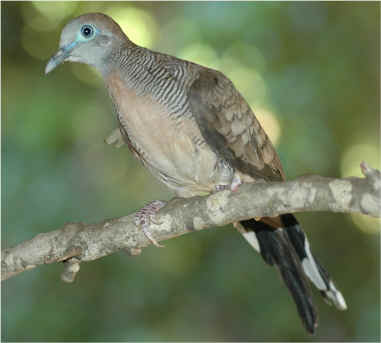
One of Our Two Zebra Doves
The zebra dove may not be as popular as the diamond dove but it is a widely kept cage bird throughout the world. In Thailand farms exist that are devoted to raising the zebra dove to sell to people living in that country who believe that having a zebra dove in the home will bring the family good luck. Their call is so special that they have cooing contests every year in Thailand.
Introduction
The zebra dove is similar to the barred dove (Geopelia maugei) and the peaceful dove (Geopelia placida). Previously all three species were included under the species name Geopelia striata. Vriends (4) indicates that there are six subspecies but does not identify them. He lists the peaceful dove and two subspecies separately, so one would assume his zebra dove subspecies do not include either of them.
Description
Zebra doves are larger than diamond doves. Our zebra doves weigh between 50 and 60 grams while our diamonds weigh between 28 and 40 grams. The zebra's body seems short and stubby when compared to the diamond dove's long, slender body.
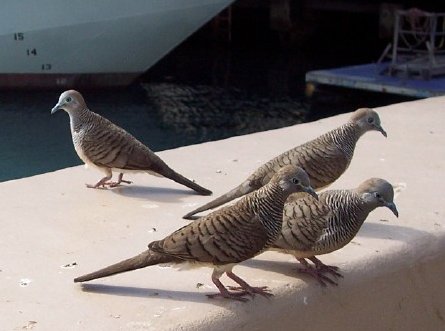
Four zebra doves looking for food in Hawaii
Photo by Kerstin Topp, Honolulu, Hawaii
In captivity it is often reported that the zebra dove is a calm, quiet bird that likes to sit in a remote place for some time and not move. Some reports indicate they are so inactive that they do not provide much interest in an aviary. However, having my zebra's inside, they seem to act quite differently as long as no strangers are present. They now seem more active than the diamonds and considerably louder. The male is not shy about doing bow coos and other sexual activity in front of me or the other birds. They are also quite territorial and even chase diamonds out of their cage after they were some distance away.
Distribution
This bird is native to southern Thailand, the Malaysian peninsula, Sumatra. Java, Bali and Lombok. It has been introduced in Borneo, Celebes, the Philippines and in more distant locations such as Tahiti, Hawaii, and the the Seychelles. Unfortunately it has been widely trapped for the cage bird trade and has become somewhat scarce in its natural range. However in Thailand the bird is so popular it is now raised on large farms.
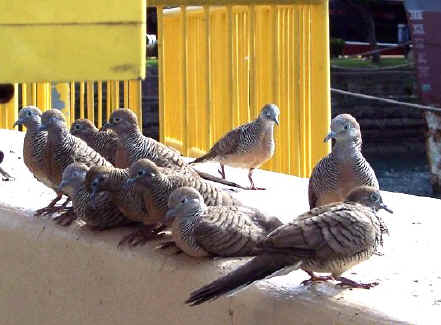
Several zebra doves waiting for tourists to feed them fish food that is sold in a nearby vending machine
Photo by Kerstin Topp, Honolulu, Hawaii
In Hawaii, there are large populations of zebra doves and they often frequent places of human habitation. They like open air restaurants where the look for food scraps and depend on being fed food discards like rice. They beg tourists for fish food that they buy to give to sea life and sometimes prefer this food to regular birds seed. And of course they visit peoples bird feeders in peoples back yards and in hi rise apartment complexes
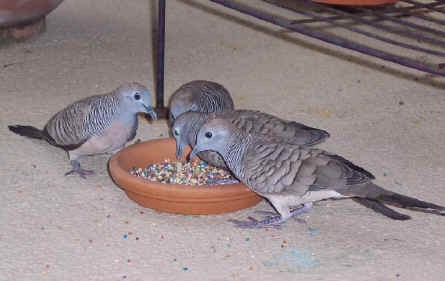
Four zebra doves eating bird seed on an apartment balcony
Photo by Kerstin Topp, Honolulu, Hawaii
Habitat
Zebra doves are usually found in dry, open habitat with some scrub vegetation which is used for cover. Sometimes they are found in dry wooded areas. Like many other doves they can be seen in villages and towns in gardens and parks, and also in cultivated areas.
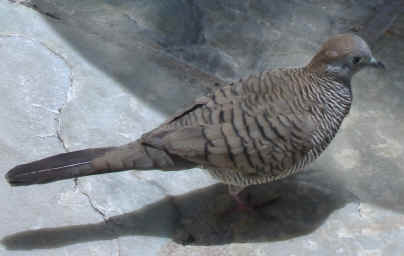
A zebra dove walking down a sidewalk in Hawaii
Photo by L R White, Honolulu, Hawaii
Feeding
Zebras feed on small seeds where the ground is bare in open spaces among thorn scrub, roadsides, paths, and in gardens. The birds also eats insects. For those who are keeping this species in a home, the directions provided for the diamond dove can be used in regards to raising a baby dove and for the food of the adult dove. See the pages titled Raising Diamonds and another titled Caring for Diamonds.
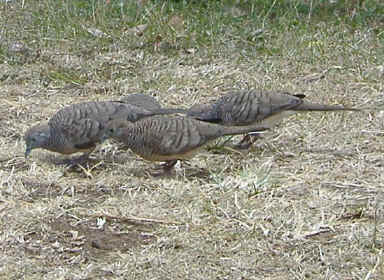
Zebra doves looking for seed in their natural habitat
Photo by L R White, Honolulu, Hawaii
Voice
The zebra doves coo is very loud for such a small bird. If you live in an apartment this may not be the bird for you. We have noted several different coos. One is a long multi note coo another is a shorter version of this coo often repeated over and over. Another coo is a ratchety sounding coo that is lower in volume than the former coos. This low rachety coo is often proceeded by very rapid head nodding and occasionally they will bow their heads to the branch they are standing on and act like the are "kissing " the branch. Once one learns to imitate their coo, they will respond to one's imitation, louder and louder each time. Almost always they will force the human to give up first
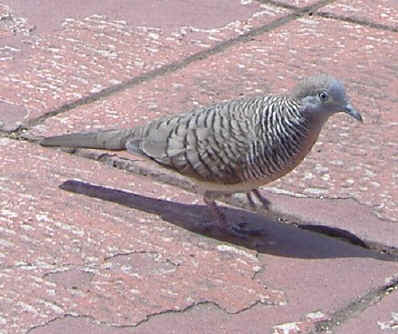
Another sidewalk zebra dove in Hawaii
Photo by L R White, Honolulu, Hawaii
Nesting
The zebra dove's bow coo (bow screech) are similar to the diamond dove's, however they stand more erect and the beak never approaches the ground. Although the tail is fanned, the spread is narrow and is much less notable than the full spread of the diamond dove. The coo is much louder than the diamond's coo and is more like a scream.
Zebra doves build a fragile nest of twigs that are usually located in a tree or shrub close to the ground or up to 12 feet high. Zebra's lay two white eggs. I have seen no information on the incubation period but I would assume that it would be 13 to 14 days as it is for the diamond dove and the peaceful dove.
About Our Doves
(February 2006)
We obtained our zebra doves from a breeder that sells his birds through a large company in February 2006. They were raised in an outside aviary and as a result were very wild when they arrived here. Upon arrival we installed them in a cage that was isolated from the rest of the birds for a week and then moved them to a location where there were diamond dove cages on each side. The zebras had no problem with the location but at first the diamonds were terrified by the new birds, puffing up and raising their wings whenever the zebras came close to them. But within a week they were sitting side by side with them on on oak branch that serves as a perch for all our doves when they are outside of their cages.
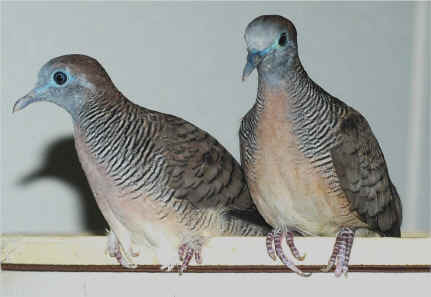
Our two zebra doves
When the birds first arrived their wing feathers were ragged and almost all their tail feathers were broken off. They may have been underweight as after they were here a month both had gained almost 10 grams in weight, going from less than 50 grams to more than 60.
Unfortunately these birds had been subject to low temperatures and had some frostbite which resulted in one infected toe and several others that were damaged. I investigated the weather record at the location where the birds were being kept and on the night of December 16th/17th 2005, the temperatures dipped below freezing and at around 6:30 AM the next morning the temperature went down as low as 19 degrees F. The temperature was above freezing by 10 AM. It seems to me that temperatures this low for such a long period would be sufficient to produce severe frostbite if the birds were not taken inside.
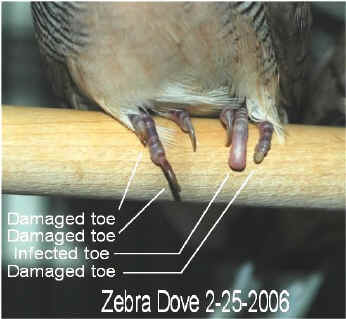
Damaged and Infected Toes
I started applying Neosporin to the toe four times a day. This bird did not want to be held while I applied the medication to its toe, but it was happy to sit on my finger while I completed the application. Once it realized what I was trying to do, it sat unrestrained on my finger while I applied the cream and rubbed it in. Within a few days I could walk around my apartment with the dove perched on my finger. But when the bird's mate called it left immediately. (For those who fear the use of this ointment because of oil damage to the feathers, we felt that no significant damage occurred). The avian veterinarian who saw the dove felt it best to continue with this treatment. There was some question about the dosage of pain medication that was being applied by using this type of Neosporin. I felt the bird was benefiting from the pain mediation because the bird would come to me when it felt it wanted more). It took a month until the toe lost its red color. Several of the claws on both birds were badly damaged but apparently it will not have an effect on their mobility or mating.
For your information we received a refund for the two dove form the company that sold them to us but there was no refund for the shipping cost or the veterinarian bills incurred.

Looking for a nesting site
The two doves cuddled every night on their perch in the cage provided for them and during the day they often sat together at some remote location in my living room. Thinking they may not want to use the nest in the cage I built a simple platform above their cage on which there were three potted plants, a small lamp that generates hear and projects light on the ceiling, and another nest box. The two birds immediately accepted this as "their" area and gently chased any of the diamonds that ventured up there. Bow coos, wing slaps, billing, and frequent "kissing" were frequently observed.
As the months passed, the two birds stopped being shy and when allowed out of their cages they always sat close to the other birds and only tried to isolate themselves when I had visitors. Sometimes they sat on the bird cage table close to where I was working on the computer. Other times they would sit on the cage roofs near one of the other birds. Once the larger bird sat on a tree branch I use for photography so close to a diamond it almost appeared as if they were cuddling together. The smaller bird was unhappy with that and soon chased the diamond away.
One of the two birds was larger than the other and I assumed that this was the male and the smaller bird was a female. However, after a few months the little bird started doing bow coos for the bigger bird as well as some of the male diamonds. He seemed to use the bow coo as a means of intimating the diamonds but despite the loud coos of the zebra, most of the time the diamonds would sit there calmly until the zebra threatened to peck them.
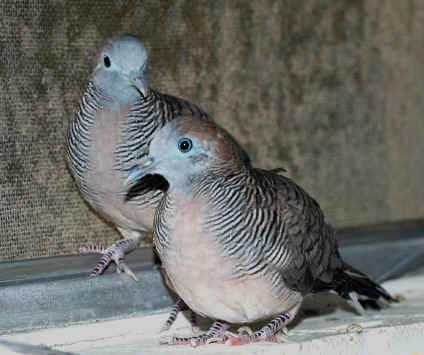
Our two zebras at the window taking sun
Anyway we incorrectly assumed that this bird was the male and the larger bird was a female. We also felt that the larger bird was older than the smaller one because of the appearance of the feathers on the bird's head.
Then a few days alater when the little bird was doing bow coos for the larger bird, the larger bird started responding with alternating bow coos. First one would bow and then the other, and this went on for some time, ever increasing in speed, and then they flew at each other in the air and I am not sure what they did because the action was fast and furious and not at all like anything I have ever observed. There was one other instance of these kind of bow coos when one of the doves was inside the cage and the other was outside. It was all very loud with violent movements.
I have no idea if this falls within the normal range of mating displays of the zebra doves. I assume it does not. Anyway we know we now have two males and not a pair
2007 to 2009
Not much new has happened since the above was written. During the day they often express the desire to get out of their cage but because they are often hard to chase down and return to their cage, I usually only take them out in the evening. Sometimes I only let the the large dove out as he never acts aggressive toward the diamond whereas the small dove does have a tendency to threaten them with his loud screaming bow coos. Another reason I don't let him out is because every time he does come out he is so happy he has to let the whole world know about it and these are both very loud birds. However even though the larger dove is loud, he does not coo as much as the smaller dove does.
Often the smaller dove comes over to me and stands about two feet away, looks me in the eye, and coos (screams) loudly. If I answer him the exchange can go on and on - but he gets louder and louder even though I get softer and softer.
Sometimes the larger bird comes to me and does this head nodding combined with a softer, ratchety sounding coo. I try to imitate him, rather poorly, and he also will respond again and again until I stop.
When they are out, they sometimes visit the big wooden cage that has a 65 watt Plant Gro lamp in it and lay down and spread their wings and tails for some period of time as do the diamonds. Sometimes they just sit on the perch in the big cage perhaps because it is warmer. They also visit the treat trays that have crushed noodles, shredded cheese, and wheat bread. And if some of the other cages are open they will go in and try eating the diamond's food which is mostly the same as theirs. For the most part they stay on the top of the cage or on the bird cage table.
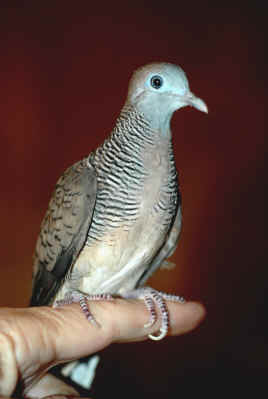
Zebra doves quickly become tame if you work with them
When I catch them in the evening after the cage lights are out, the smaller dove often requires me to go back and forth across the living room five times or more. Then I take him to the bedroom to look at his toes and beak and he becomes very calm and quietly sits on my finger while I examine and trim his toes using magnifying equipment. After that he seems happy to be petted and cuddled indefinitely before I take him back to his cage. He does not show any indication of wanting to leave. But neither does he show any facial signs of affection, wing shaking, or kissing.
The larger dove often allows me to pick him up without chasing her. Once I take him into the bedroom to examine him, he too wants to perch on my finger, and then will calmly sit there while I look at his toes and /or clip his nails. The toe that was infected seems to have recovered, but occasionally it appears redder than other times and I apply a medication to reduce the color and also to show him that I care about that toe. He always seems to welcome the application medication perhaps because of the memory of how the Neosporin reduced the pain when he had a real infection. Like the smaller dove, he is happy to be cuddled and petted after looking at his feet and lately he shows no indication that he wants to leave.
We have thought about trying to purchase two females for these two males, but at this time space considerations prevent doing that.
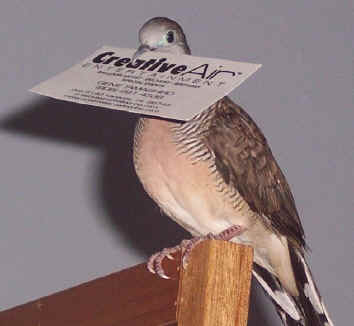
Tweety Giving Out Business Cards
Photo by Kerstin Topp, Honolulu, Hawaii
References
(1) Gibbs, David; Barnes, Eustace; Cox, John "Zebra Dove,
Geopelia striata", Pigeons and Doves, A Guide to Pigeons and Doves of the World, London: Yale University Press 2001, pp.
312-313
(2) Goodwin, Derek, "Zebra Dove, Geopelia striata", Pigeons and Doves of the World, London: Trustees of the British Museum (Natural History), 1967, pp.
172-173
(3) Gos, Michael W., Doves. Neptune City, NJ: T.F.H. Publications, Inc., 1989,
pp. 13, 41.
(4) Vriends, Matthew M., PhD., "Zebra Dove (Geopelia striata)", Doves, A Complete Pet Owner's Manual. Happauge, NY: Barrons Educational Series, Inc., 1994 ,
p. 84
P. O. Box 367,
Tallahassee, FL 32302-0367
Last revised on: November 5, 2012